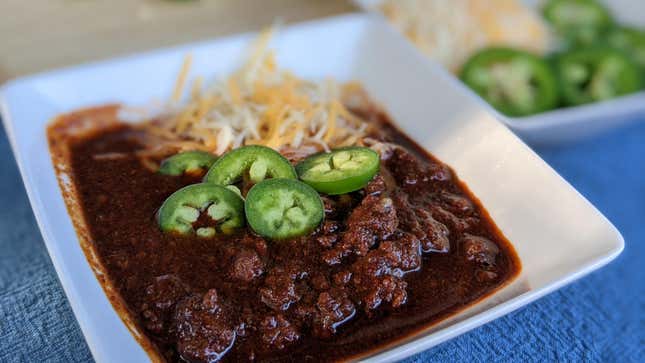
If you’re looking to pick a fight in Texas, start telling people that chili is supposed to be made with beans. As baffling as it might sound to outsiders, many of whom can’t imagine chili without them, legumes are considered taboo when it comes to Texas chili, or “Texas Red” as it is known to natives of the Lone Star State.
I asked a trusted group of Texas-based chefs and food writers why Texas chili can’t have beans. Even over emails and text, the passion at times got as fiery as a bowl of pequin peppers.
How Texas eats its chili
“In Texas, we hold these things to be true: Texas BBQ is the king, and there are no beans in chili,” says acclaimed chef, barbecue pitmaster, and eighth-generation Texan John Bates. Sure, one can expect that kind of bravado from a Texan—but then he hits me with a metaphor.
“Every champagne is [sparkling] wine, but not every [sparkling] wine is champagne,” he says. “The same is true in that every chili is a stew, but not every stew is chili. Ingredients matter.”
So, much like particular French wines and Italian cheeses, Bates is saying that if a bowl of chili includes beans, it’s not just inferior to Texas Red. Instead, it isn’t chili at all.
Fellow pitmaster Tom Micklethwait, owner of Micklethwait Craft Meats in Austin, has a softer stance on the beans-in-chili debate.
“I think the beans argument is kinda silly,” Micklethwait says. “I like both! It’s not really a question of what is ‘right’ or ‘wrong’ or more ‘Texas-y.’ To me, the better question about whether or not chili should have beans is, ‘What are you gonna do with that chili?’ I don’t want beans in my chili [if it’s] on a hot dog or Frito pie. I do want beans in my chili if it’s an a la carte dish. Like, just a bowl of chili.”
Micklethwait brings up an excellent point: that chili can be either a dish or a topping. And when using it as the latter, we must consider the earliest version of chili in Texas. I’m talking about chili con carne.
The origins of Texas chili
In a 2008 Houston Press article, Texas food historian Robb Walsh writes that the predecessor to Texas Red was chili con carne, which was “introduced to America by the ‘Chili Queens,’ women who served food in San Antonio’s Military Plaza as early as the 1860s.” This early version of Texas Red was served over tamales, and though it occasionally came with beans, these were served on the side.
Chile con carne exists today in Tex-Mex restaurants primarily as a topping for dishes such as enchiladas, and it’s thinner than what we think of as chili. As José R. Ralat of Texas Monthly tells The Takeout, “While we might all know the meaty, chile-spiked stew that is Texas chili, chili con carne is more of a gravy that tends to harden like Magic Shell on ice cream.”

When did chile con carne evolve into its offshoot Texas Red? Probably around the same time chili powder was marketed and made chili easy to prepare, which by many estimates was somewhere around 1900. In the same Houston Press article, Walsh notes that by the 1920s chili started to turn up in the Midwest, “on top of spaghetti in Ohio, on hot dogs in Michigan, and in omelets and casseroles,” as the dish became easier to prepare with store-bought seasonings and thus grew more popular over time.
From there, chili evolved regionally. Greek immigrants, for example, contributed to Cincinnati chili by making a version similar to bolognese, adding warming spices like cinnamon (which, as it turns out, goes great with a pile of spaghetti). In Texas, chili con carne became Texas Red, and crucially, it steadily grew in popularity among home cooks.
By the mid-20th century, chili cook offs would emerge and further define the legacy of chili in Texas. Most notable among these is the Terlingua Chili Cook Off, established in 1967 and considered the grandaddy of them all. What started out as a bit of a publicity stunt between two chili aficionados grew into half a century’s worth of Texas chili history. Clearly stated in the rules: no beans, nor any other kind of filler. My apologies to macaroni, hominy, and rice.
Why the chili debate will never die
Given the annals of history and the stern rules of official competitions, it would seem that beans have no place in Texas chili. Yet they somehow remain acceptable among some Texans. Because here’s the thing—Texans love beans. Almost every barbecue joint I’ve ever visited in the Lone Star State serves pinto beans, and many of my favorite spots, like those mentioned above, serve beans with bits of brisket. Unsurprisingly, it’s delicious.
So why the beef with beans in chili? The answer has a lot to do with honoring tradition, even though not every Texan has such hard and fast rules within their own recipes. Chris Hughes, editor at Austin Monthly, thinks the debate is “ridiculous.”
“To me it’s just drunk food,” he says of chili. “It’s easy to make and takes time. So it’s an excuse to drink and watch football.”
My advice is this: If you happen to make chili for a Texan and there are any beans present, you’d better hope the Cowboys win that day, or at least cover the spread.